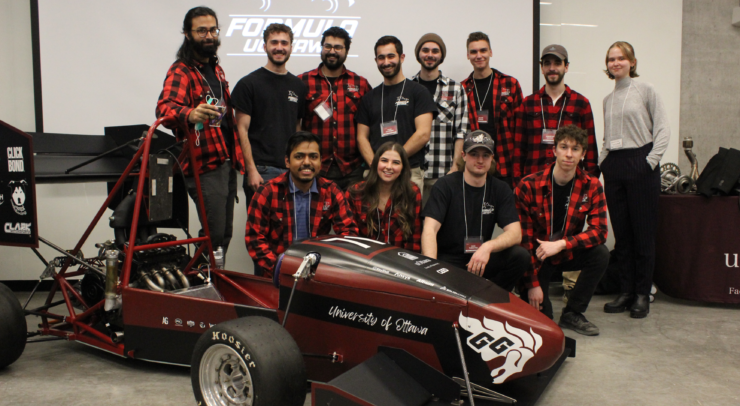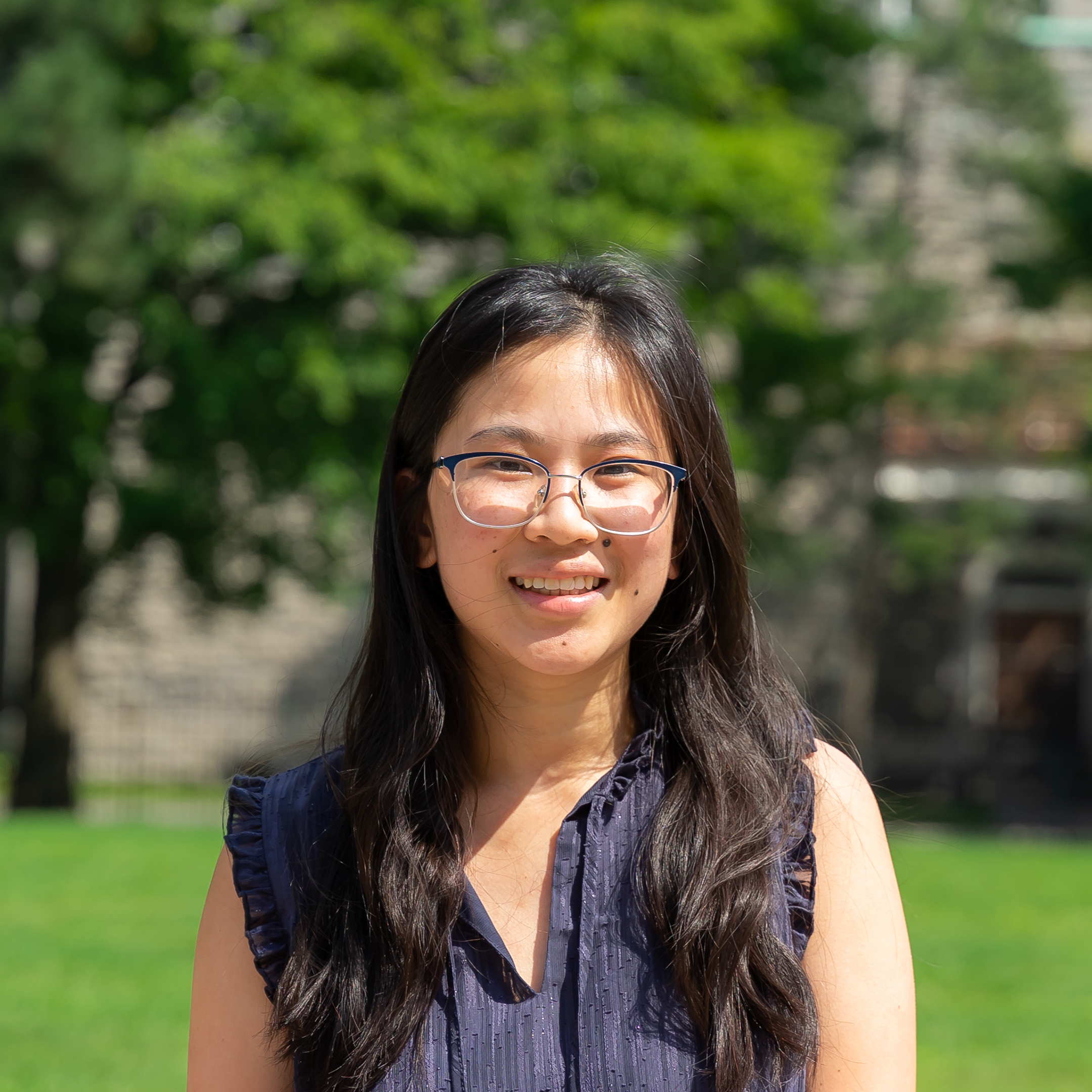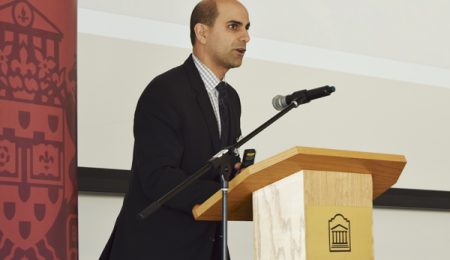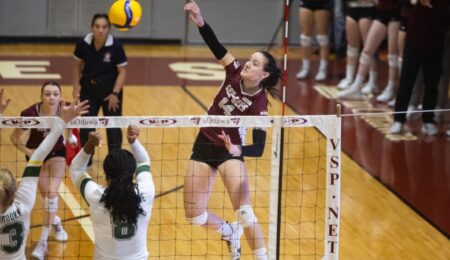READY, SET, GO!
In a previous interview with the U of O formula team, there was talk of manufacturing a new 2022 FSAE car. After months of hard work, led by senior technical director Armin Teymouri and team manager Ibrahim Chohan, Formula uOttawa excitedly showed off the Gee-Gees racecar (GGR22) during their unveiling event on April 1.
In case you missed the unveiling, here’s a recap of what’s new and what to expect as the team prepares for the 2022 racing season.
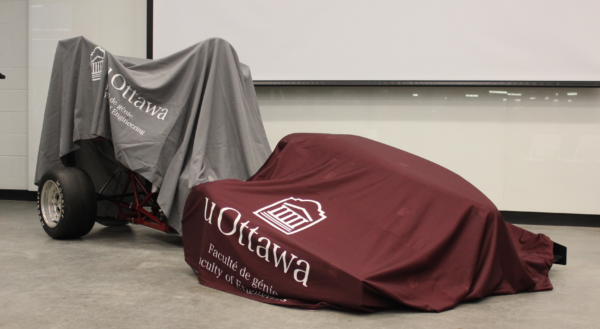
Build process
In terms of the build process, the team started off by asking themselves what they want to accomplish this year, whether it’s modifying the car, testing the older car, or building a brand new one.
“This year, we’re running an aerodynamic package, that was one of the major design decisions that we made, and that’s impacted our design entirely. It’s very much you choose what you want to achieve in terms of design, and that decides the entire layout of the year,” said Chohan in an interview.
He continued, “from there the design flows out very systematically. Since we wanted to add the aero package we started investigating how adding that system will impact other systems and designs. We start with the literature review, then we go into the preliminary design, [cycle] through a few different iterative designs and analyses, so that’s sort of how it ends up going.”
Unveiling the 2022 car
The process starts with the chassis, which, according to Teymouri, essentially ties the suspension points of the car to all the other critical components and provides a safe structural body.
He added, “this year we didn’t change anything too radically, we’ve made some small modifications for clearance with the new aerodynamic package in the front. We raised the height of the front roll hoop just for ergonomic purposes and also to package the electronics that are hidden under the hood.”
Previous iterations of the car have had massive chassis and some that were too small. The team has focused more on staying somewhere in the middle and have plans to carry that forward.
The most noticeable difference between the previous 2018 car and the new car is the added aerodynamics package. The main idea behind the package was based on previous observation that the car was understeering on the track.
Although Teymouri was responsible for the analysis and simulation of the airfoils and setup, Hassan Zakis‚ one of the senior design engineers — was in charge of the actual assembly layout and ensuring everything can be mounted on the car.
“When we go into the corners, we would notice the rear end would have no grip on it and it would just slip out. To improve that, we wanted to include some downforce and aerodynamics onto the car to help with stability and driving dynamics,” explained Zaki.
He added, “Dan Turkstra, [one of the team drivers] gave me a lot of feedback in terms of what areas needed to be adjusted, where he felt the car was losing balance. Based on that, I was able to set up a base package and from there we’re going to be making a lot of improvements too.”
The airfoils themselves (wings) are made of foam, which the team spent time prototyping. However, a company called Foam Geometrics was able to cut the pieces for free. From there, they were wrapped in carbon fibre and infused in-house at the University of Ottawa. In addition, the bodywork, nose, and hood were also all made at the University.
In terms of the guts of the car, engine cooling was a big issue in previous years. The engines in earlier cars would run too hot and overheat. One reason for this, according to Teymouri, was due to the fact that the exhaust was rear-mounted in an area that doesn’t receive a lot of air flow.
To combat this, “we decided to do a side-mounted radiator in an area with a lot of freestream velocity air. We’ve designed a shroud for it, and we’re using a higher cubic feet per minute fan that doesn’t draw as much current compared to the 2018 car that would kill the battery,” added Teymouri.
Putting the radiator in a position where there can be ample air flow by virtue of the car moving in addition to a better fan can hopefully improve previous cooling issues for the team.
This year, electronics was mainly overseen by Zaki and was aided by Victoria Hough, a junior team member. According to Zaki, last year’s electrical system was standard in terms of the automotive layout by using heavy-duty fuses and relays which require more power. This year the team decided to go for a more modern, lightweight approach.
“We used a mosfet based design (Metal Oxide Semiconductor Field Effect Transistor) because they’re a lot lighter and we had the time to implement them. This approach helped us save about six pounds overall and simplified the system which should improve our diagnostics moving forward as well as on the track,” added Hough and Zaki, respectively.
The biggest challenge
Chohan and Hough stressed the importance of time management due to the scale of the project and because there are often a lot of moving parts involved. In addition, the team is mainly composed of engineering students who are also balancing work, school, etc. As a result, the project has really thrived on input from everyone whether small or large.
What’s next for the team?
One of the big events the team is preparing for is FSAE Michigan May which is an official international event hosted by the formula society of automotive engineers. The competition is composed of a series of static and dynamic events to judge competitors’ cars.
“Static events are like design cost, business case, like all the stuff that you could just do in a presentation. And the dynamic events are where you actually go to the track. We do stuff like autocross acceleration, endurance, and skidpad. To be able to compete in the dynamic events, you have to pass a rigorous technical inspection,” said Teymouri.
The team is always looking for new enthusiastic members to join, regardless of experience or expertise. The time you have with formula uOttawa is indeed what you make of it and if you’re looking to get your hands dirty there is a lot to do.
For more information about Formula uOttawa and how to get involved, you can visit their website here.

